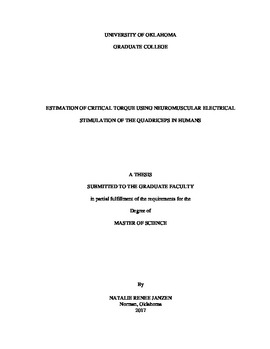| dc.description.abstract | Critical torque (CT) is an integrative measure/concept that represents the “critical” or upper boundary of steady-state work that can be performed without leading to exhaustive fatigue. While this concept has been observed across multiple voluntary exercise modalities, it has not been tested using neuromuscular electrical stimulation (NMES). PURPOSE: The purposes of this study were to 1) observe if an electrically stimulated exercise protocol in the quadriceps results in a hyperbolic power-duration pattern seen in voluntary contractions, and 2) determine if the decline in torque production over time during electrically stimulated exercise occurred due to similar mechanism(s) as the decline in torque during voluntary exercise. METHODS: Participants (Men = 6, Women = 8) completed 2 familiarizations and 3 testing visits. Voluntary CT (VOL) and involuntary end-test torque (ETT) were assessed at several frequencies including 100 Hz, an intermediate frequency (Intermediate; 15-30 Hz) and a frequency that elicited a torque below the ETT of 100 Hz (Below; <15 Hz). Twitch torque (TT), low frequency fatigue (LFF), M-wave amplitude, and lactate were measured during each exercise protocol, and %ACT was assessed during the VOL test. RESULTS: ETT was calculated as the mean peak of the last 7 contractions for the stimulated exercises. Mean and relative ETT was significantly different from starting torque for each of the 100 Hz and Intermediate (15-30 Hz) protocols (p ≤ 0.002), but ETT was not significantly different across protocols (p ≥ 0.127). ETT of the Below protocol did not change from starting (p ≥ 0.558), and ETT was significantly lower than any of the other stimulated protocols (p ≤ 0.035).VOL TT declined approximately 60% from starting TT (p ≤ 0.014). TT declined about 50-60% during the 100 Hz protocols (p ≤ 0.018). Except for transient increases in the middle of the protocol, there were no changes in TT for the Below protocol (p ≥ 0.052).VOL LFF ratio was significantly reduced from pre exercise measures at all post exercise time points (p ≤ 0.004). There was acute high frequency fatigue immediately after all of the stimulated protocols (p ≤ 0.040). M-wave amplitude decreased about 10% from pre to immediately post (IP) for the 100 Hz protocols (p ≤ 0.027). There were no changes in M-wave amplitude for VOL, Intermediate, and Below protocols (p ≥ 0.19). Lactate levels during VOL were significantly higher than of all of the stimulated protocols IP and 3-min post (3P) exercise (p ≤ 0.001). The 100 Hz protocols were significantly higher than the Below protocol at both IP and 3P measures (p ≤ 0.018). The 100 Hz protocols were not significantly different from the Intermediate protocol at IP (p ≥ 0.59), but D2 was significantly higher than Intermediate at 3P (p = 0.044), while D1 was not (p = 0.598). Lactate during IF was not significantly higher than Below at IP (p = 0.234), but was higher at 3P (p = 0.017). CONCLUSIONS: Despite differences in fatigue mechanisms, NMES exercise at 100 Hz and at intermediate frequencies declined to a similar torque value, while exercise under ETT showed no declines in torque. These findings suggest that the observed threshold during NMES exercise is CT. | en_US |
